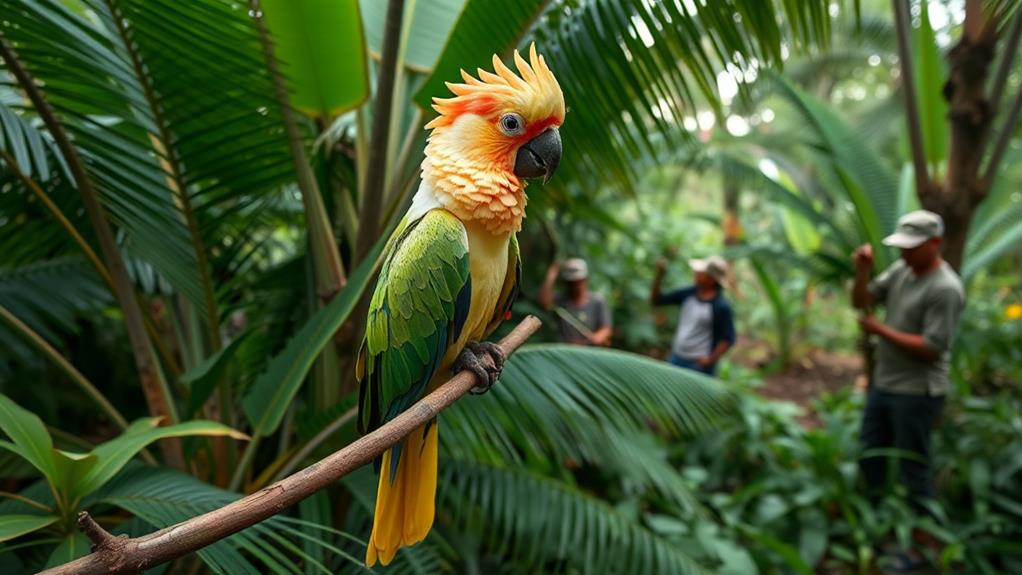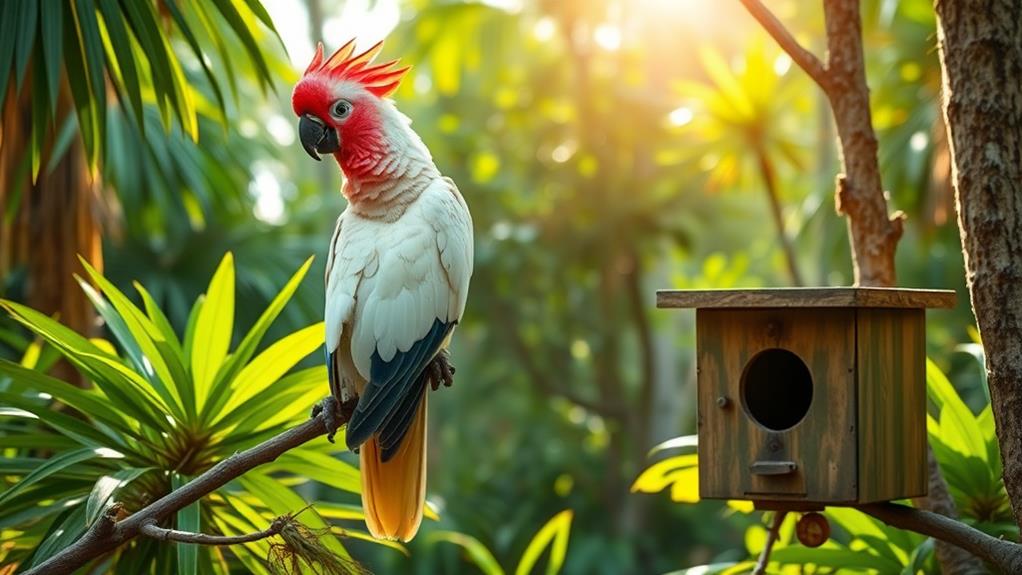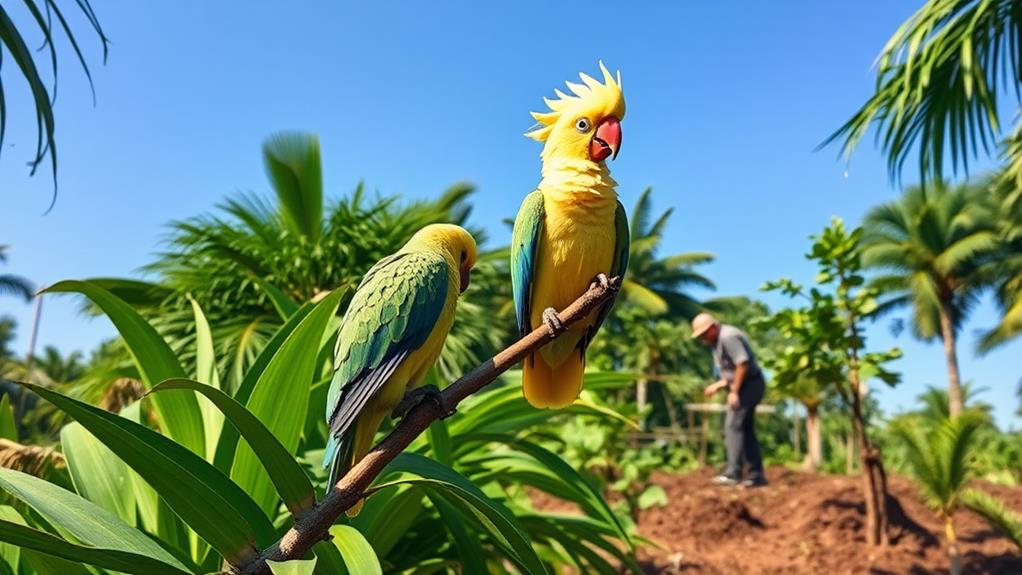The Philippine Cockatoo is critically endangered due to poaching and habitat loss. The main threats to its survival are the illegal pet trade and the destruction of its natural habitat.
Conservation efforts focus on community involvement, breeding programs, and protected reserves. One successful initiative is led by the Katala Foundation, which has increased the population on Rasa Island from 25 in 1998 to over 350. This achievement is a result of engaging local communities, including training ex-poachers as wildlife wardens.
These programs promote sustainable practices and ensure the long-term survival of the species.
Ongoing partnerships and public awareness campaigns are crucial for conservation. By working together and raising awareness about the importance of conservation, these collective actions are shaping a better future for the Philippine Cockatoo.
Overview of the Philippine Cockatoo

The Philippine Cockatoo: A Critically Endangered Species
The Philippine cockatoo, a small and vibrant species, is a vital part of the Philippines’ biodiversity. It is classified as critically endangered by the IUCN due to a drastic 80% population decline over the past 40 years.
Habitat loss and poaching are the primary causes of this decline. Currently, only 820 to 1,280 individuals remain, with a significant portion concentrated in four project sites on Palawan, the species’ last stronghold.
These intelligent birds are known for their remarkable abilities, such as mimicking human speech and displaying engaging behaviors like singing and dancing. These traits not only make them fascinating but also highlight the importance of their conservation.
Conservation efforts are underway to protect the Philippine cockatoo, including community involvement and conservation breeding programs.
These initiatives aim to combat poaching and restore habitats by fostering local engagement. Supporting these efforts is crucial for ensuring the survival of this unique species and maintaining ecological balance in the regions they inhabit.
Major Conservation Challenges
Conservation Challenges Threaten the Philippine Cockatoo’s Survival
The Philippine cockatoo population has plummeted by 80% over the past 40 years, primarily due to rampant poaching and habitat loss. This drastic decline has led to its classification as Critically Endangered by the IUCN.
Remote and Volatile Regions Complicate Conservation Efforts
Conservation work is hindered by the remote and volatile regions where the Philippine cockatoo resides. For instance, police or military escorts are often necessary, significantly increasing operational costs.
Inconsistent Government Prioritization Undermines Conservation
Local government prioritization of conservation varies widely, which can undermine consistent and effective initiatives. This inconsistency hampers conservation efforts and creates uncertainty for stakeholders.
The COVID-19 Pandemic Exacerbates Conservation Challenges
The COVID-19 pandemic has worsened conservation challenges, impacting health and funding for ongoing projects. This has further complicated population assessments and increased the risks faced by conservation workers.
Security Concerns Create Additional Complications
Security concerns in areas like the Sulu archipelago create further complications, making population assessments troublesome and increasing the risks that conservation workers face.
Collaboration is Key to the Philippine Cockatoo’s Survival
To ensure the survival of the Philippine cockatoo, stakeholders must address these challenges head-on.
Katala Foundation’s Key Initiatives

Targeted Initiatives for Philippine Cockatoo Conservation
The Philippine cockatoo’s survival relies on effective conservation initiatives. Since 1998, the Katala Foundation has implemented the Philippine Cockatoo Conservation Program (PCCP) to combat the species’ decline.
The program’s success is evident in the population growth from 25 individuals on Rasa Island in 1998 to over 350 by 2021.
Ex-Poachers Turned Wildlife Wardens
The foundation employs ex-poachers as wildlife wardens, leveraging their local knowledge for effective conservation outcomes.
This community-based conservation approach transforms former poachers into protectors of the cockatoo.
Protected Reserves in Palawan
The establishment of four protected reserves in Palawan has been crucial, as
these areas now house 69% to 86% of the global cockatoo population.
Conservation Education and Collaboration
The foundation prioritizes conservation education, engaging local communities to raise awareness and promote sustainable practices.
Collaborating with municipalities and international organizations enhances resource allocation and ensures the longevity of these initiatives.
Rescue, Captive Management, and Capacity Building
The Katala Foundation remains committed to the preservation of the Philippine cockatoo through rescue and captive management, as well as capacity building.
Community Involvement Strategies
Community Involvement is Key to Conservation Success
The Philippine Cockatoo Conservation Program (PCCP) relies heavily on community involvement to protect the critically endangered Philippine Cockatoo. By engaging local people, the program fosters a sense of ownership and ensures effective conservation. For instance, the Katala Foundation employs former poachers as wildlife wardens, providing them with a stable income and transforming them into protectors of the species.
Raising Awareness and Pride
PRIDE campaigns raise awareness about the Philippine Cockatoo, promoting local pride and understanding of its ecological importance. Additionally, conservation education programs target local schools and urban populations, creating a deeper connection with wildlife. These initiatives help build a sense of responsibility among local communities, encouraging them to take action in protecting the cockatoo.
Community Involvement Strategies
The PCCP employs several strategies to engage local communities in conservation efforts:
| Strategy | Description |
|---|---|
| Capacity-Building Initiatives | Equip local communities with skills for habitat restoration and monitoring. |
| PRIDE Campaigns | Raise awareness and instill pride in local biodiversity. |
| Collaboration with Stakeholders | Engage landowners and government for sustainable habitat management. |
These strategies empower local communities to take an active role in protecting the Philippine Cockatoo and its habitat, ensuring the long-term success of the conservation program.
Success Stories in Population Recovery

Conservation Efforts Pay Off for the Philippine Cockatoo
The Philippine Cockatoo has made a remarkable recovery in recent years due to dedicated conservation efforts. The population on Rasa Island surged from 25 individuals in 1998 to over 350 by 2021. This success is largely attributed to the initiatives led by the Katala Foundation, which have stabilized cockatoo populations in four project sites, with estimates ranging between 820 to 1,280 individuals, representing 69% to 86% of the global population.
Community Involvement Key to Success
The recovery of cockatoo populations is largely due to community involvement. Training ex-poachers as wildlife wardens has empowered local individuals to contribute their knowledge while actively protecting cockatoo nests from threats like poaching for the pet trade.
Additionally, the establishment of four protected reserves has been crucial, supporting habitat restoration and facilitating ongoing population monitoring.
Collaborative Efforts Lead to Sustainable Model
The successful increase in the wild Philippine Cockatoo population showcases the effectiveness of collaborative efforts between local communities, conservation organizations, and government agencies.
Together, they’ve created a sustainable model that not only protects these remarkable birds but also fosters community pride and stewardship for their environment.
Collaborative Conservation Efforts
Collaborative Conservation Efforts Are Crucial for the Recovery of the Philippine Cockatoo
Collaborative conservation efforts are essential for the recovery of the Philippine Cockatoo. To achieve this, organizations partner with local municipalities like Narra, Dumaran, and Balabac to enhance their conservation work effectively.
Effective Management through Partnerships with NGOs
Partnering with organizations like Loro Parque Fundación and the North of England Zoological Society provides essential resources and expertise for effective management. These partnerships enable the sharing of knowledge, skills, and resources, leading to better conservation outcomes.
Utilizing Local Knowledge for Better Protection
Employing ex-poachers as wildlife wardens transforms them into protectors of the cockatoo population. This approach leverages their understanding of the local environment and wildlife behavior, resulting in better monitoring and protection of the species.
Strengthening Wildlife Law Enforcement through Training
Implementing training programs for prisoners and military personnel strengthens wildlife law enforcement. This targeted approach addresses poaching threats at critical breeding sites, ensuring the protection of the Philippine Cockatoo and its habitats.
Community Engagement Promotes Sustainable Practices
PRIDE campaigns promote local pride in the Philippine Cockatoo, encouraging sustainable practices that benefit both wildlife and communities. By engaging local communities in conservation efforts, their involvement ensures long-term conservation success.
These collaborative efforts not only enhance the protection of the Philippine Cockatoo but also involve the community in meaningful ways, ensuring a brighter future for this threatened parrot. Local conservation organizations work with indigenous communities to educate them on the importance of preserving the Philippine Cockatoo and its habitat. By engaging the community in conservation initiatives, there is a greater chance for long-term success in protecting this species. Additionally, these efforts also help in creating awareness about the importance of biodiversity and the role each individual can play in preserving it. Understanding Philippine tarsiers behavior can further aid in the development of conservation strategies that benefit not only the cockatoo but other threatened species as well.
Future Directions for Conservation

Future Directions for Conservation
To ensure the survival of the Philippine Cockatoo, strategic expansion and sustained commitment are essential. The ongoing conservation work aims to maintain and increase the population of this endangered species, currently estimated at 820 to 1,280 individuals.
Long-term monitoring is crucial for establishing effective conservation programs that can adapt to changing environmental conditions and threats. This involves continuous tracking of the population’s size, habitat, and behavior to inform conservation strategies.
Strengthening partnerships with organizations and municipalities is key. By enhancing resource allocation and collaborative initiatives, the overall impact of conservation efforts can be improved.
For instance, partnering with local municipalities can facilitate the establishment of protected areas and enforcement of anti-poaching laws.
Advocating for the expansion of protected areas is vital to safeguard the habitat of the Philippine Cockatoo and mitigate the effects of poaching. This can be achieved by working with government agencies and local communities to designate and manage protected areas effectively.
Global connections among conservationists are necessary for knowledge sharing and collaborative strategies. By promoting sustainable livelihood alternatives, local dependence on practices that lead to habitat loss and poaching can be reduced.
For example, providing education and training on sustainable agriculture practices can help reduce deforestation and habitat destruction.
Importance of Public Awareness
Raising Public Awareness is Crucial for the Philippine Cockatoo’s Survival
With fewer than 1,200 individuals remaining in the wild, public awareness is essential for the conservation of the critically endangered Philippine Cockatoo.
Community Engagement is Key
Local communities can take pride in protecting the Philippine Cockatoo. By participating in initiatives like the PRIDE campaigns, individuals can foster community pride and encourage local stewardship toward the species.
Habitat Preservation Requires Public Support
Public awareness drives support for habitat preservation, which is vital for safeguarding the remaining populations from habitat loss. The Philippine Cockatoo’s habitat is under threat, and increased awareness can mobilize communities to take action.
Combating Poaching Requires Education
Educating the public about the threats of poaching can mobilize communities against illegal activities, protecting this beautiful parrot. Poaching is a significant threat to the Philippine Cockatoo, and public awareness can help combat this issue.
Biodiversity Conservation is Interconnected
The Philippine Cockatoo’s conservation highlights the importance of biodiversity. Understanding the ecological importance of the species emphasizes the need for biodiversity conservation and the interconnectedness of species.
Active Engagement Secures a Brighter Future
Actively engaging in raising awareness through media outreach and community events inspires future conservationists and secures funding for ongoing conservation work.
Together, we can ensure a brighter future for the critically endangered Philippine Cockatoo and enhance the overall health of our ecosystems.
Questions and Answers
What Is the Philippine Cockatoo Conservation Program?
The Philippine Cockatoo Conservation Program primarily focuses on habitat restoration and wildlife protection. This is achieved through community involvement, where local stakeholders are engaged in breeding programs and educational outreach activities.
These initiatives raise awareness about conservation among local communities, promoting the importance of preserving the Philippine Cockatoo’s habitat.
Research initiatives play a crucial role in informing conservation strategies. By conducting research, the program ensures that its partnerships with local communities are successful and maximize impact.
The program receives funding from various sources, which enables it to sustain its efforts and promote long-term survival of the Philippine Cockatoo.
Ultimately, the program empowers local communities to actively participate in preserving their unique environment and species. By doing so, it contributes to the conservation of the Philippine Cockatoo and its habitat, ensuring the species’ survival for generations to come.
Are Cockatoos Critically Endangered in the Philippines?
Cockatoos are critically endangered in the Philippines due to habitat loss and illegal trade.
Habitat loss occurs when forests are cleared for agriculture, urbanization, and logging, leaving cockatoos without their natural habitat. Illegal trade, on the other hand, involves capturing cockatoos for the pet trade, further reducing their population.
Community involvement and government policies are essential for their conservation.
By participating in community initiatives, individuals can raise awareness about the importance of protecting cockatoos and their habitats. Government policies, such as laws and regulations, can also help prevent habitat destruction and illegal trade.
Breeding programs and wildlife sanctuaries play a vital role in their recovery.
Breeding programs help increase the population of cockatoos, while wildlife sanctuaries provide a safe habitat for them to thrive. These sanctuaries also help to educate people about the importance of conservation.
Staying informed and engaged is crucial for their survival.
Are Parrots Endangered in the Philippines?
Many parrot species in the Philippines are endangered. Habitat loss and illegal trade are primary threats to their survival. The destruction of their natural habitats due to deforestation and urbanization has led to a significant decline in parrot populations.
Additionally, the illegal pet trade has further exacerbated the problem, as many parrots are captured and sold on the black market.
Conservation efforts are hindered by several challenges. Limited resources, inadequate law enforcement, and lack of public awareness about the importance of parrot conservation are significant obstacles.
Moreover, the remote and inaccessible locations of parrot habitats make it difficult for conservationists to monitor and protect these areas.
To mitigate these threats, habitat restoration and breeding programs are essential. Restoring habitats can provide parrots with a safe environment to thrive, while breeding programs can help increase their populations.
Supporting conservation organizations and participating in community-based initiatives can make a significant difference. By engaging local communities in parrot conservation, we can foster a collaborative approach to protect their habitats and mitigate threats.
What Is the Cockatoo Endangered Status?
Habitat Loss and Illegal Trade Threaten Cockatoo Survival
The cockatoo’s endangered status is primarily caused by severe habitat loss and illegal trade. Deforestation and land conversion have led to the destruction of cockatoo habitats, making it difficult for them to find food, shelter, and breeding grounds.
Additionally, the illegal trade of cockatoos as exotic pets has significantly reduced their population.
Supporting Conservation Efforts
To help recover cockatoo populations, breeding programs are essential. These programs aim to increase the number of cockatoos in controlled environments, reducing the demand for wild-caught birds and promoting species recovery.
Raising awareness through campaigns can engage community involvement, highlighting the ecological significance of cockatoos and promoting conservation efforts.
Conservation Funding and Community Involvement
Conservation funding plays a vital role in protecting cockatoo habitats and combating poaching. This funding supports initiatives such as habitat restoration, research, and law enforcement, ensuring ongoing efforts to safeguard cockatoo populations.
Community involvement is crucial, as it helps to spread awareness and promote conservation efforts, ultimately contributing to the protection of these remarkable creatures.